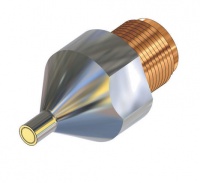Power of piezoceramics

Researchers at Birmingham University have developed a process to build ultrasound transducers that operate at more than three times the frequency of conventional devices. They believe the process could enable the development of a new breed of medical imaging devices where high resolution and low surface penetration are demanded.
Ultrasound-based diagnostic imaging systems have been used to create images of subcutaneous body structures. Such systems which work at frequencies above the audible range of human hearing employ piezoelectric transducers that are placed on the surface of a body to be imaged. When excited by an electrical stimulus, these transducers create an ultrasound signal that penetrates the body. Reflected signals from features in the body are then detected by the same transducer and converted back into electrical signals that are processed to obtain an image.

Button said: ’The process creates a dense material almost identical to that produced by conventional processes, with the exception that the fine-scale structure of ceramic material is already encapsulated within it, obviating the need to perform machining processes to produce the pillars of ceramic material.’
Register now to continue reading
Thanks for visiting The Engineer. You’ve now reached your monthly limit of premium content. Register for free to unlock unlimited access to all of our premium content, as well as the latest technology news, industry opinion and special reports.
Benefits of registering
-
In-depth insights and coverage of key emerging trends
-
Unrestricted access to special reports throughout the year
-
Daily technology news delivered straight to your inbox










Water Sector Talent Exodus Could Cripple The Sector
Well let´s do a little experiment. My last (10.4.25) half-yearly water/waste water bill from Severn Trent was £98.29. How much does not-for-profit Dŵr...